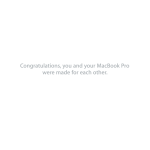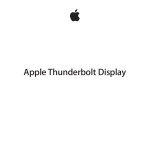Download Apple Mac mini (Mac OS X Server Specifications
Transcript
Congratulations, you and your Mac mini were made for each other. Say hello to your Mac mini. www.apple.com/macmini Finder Browse your files the way you browse your music with Cover Flow. Mac Help finder Mail Manage all your email accounts in one place. Mac Help mail iCal Keep your schedule in sync. Mac Help calendar Mac OS X Snow Leopard www.apple.com/macosx Time Machine Automatically back up and restore your files. Mac Help time machine Quick Look Instantly preview your files. Spotlight Find anything on your Mac. Mac Help quick look Mac Help spotlight iMovie Make a greatlooking movie in minutes. GarageBand Create a greatsounding song with ease. iMovie Help movie GarageBand Help record iLife ’11 www.apple.com/ilife iPhoto Turn your photos into something amazing. iPhoto Help photos Safari Experience the web with the fastest browser in the world. Mac Help safari Contents Chapter 1: Ready, Set Up, Go 10 What’s in the Box 11 Setting Up Your Mac mini 18 Putting Your Mac mini to Sleep or Shutting It Down 22 24 26 28 28 Chapter 2: Life with Your Mac mini What’s on the Front of Your Mac mini What’s on the Back of Your Mac mini Using the Apple Remote Using SD Cards Getting Answers Chapter 3: Boost Your Memory 34 Installing Memory Chapter 4: Problem, Meet Solution 44 46 47 48 Problems That Prevent You from Using Your Mac mini Reinstalling the Software That Came with Your Mac mini Resetting Your Password Using Disk Utility Contents 5 48 50 50 53 54 54 56 Other Problems Using Apple Hardware Test Problems with Your Internet Connection Problems with AirPort Extreme Wireless Communication Keeping Your Software Up to Date Learning More, Service, and Support Locating Your Product Serial Number Chapter 5: Last, but Not Least 59 Important Safety Information 61 Important Handling Information 63 Understanding Ergonomics 65 Apple and the Environment 67 Regulatory Compliance Information Looking for Something? 72 Index 6 Contents 1 Ready, Set Up, Go www.apple.com/macmini Mac Help Migration Assistant Your Mac mini is designed so that you can easily set it up and start using it right away. If you’ve never used a Mac mini or are new to Mac computers, read this section for instructions about getting started. Important: Before you plug your Mac mini into a power outlet, read all the installation instructions and the safety information starting on page 59. If you’re an experienced user, you may already know enough to get started. Be sure to look over the information in Chapter 2, “Life with Your Mac mini,” to find out about the features of your Mac mini. Answers to many questions can be found on your Mac mini in Mac Help. For information about Mac Help, see “Getting Answers” on page 28. Chapter 1 Ready, Set Up, Go 9 What’s in the Box Your Mac mini comes with the following components: Power cord HDMI to DVI Adapter Follow the steps on the next several pages to set up your Mac mini. 10 Chapter 1 Ready, Set Up, Go Setting Up Your Mac mini Place your Mac mini right side up on a firm surface. Use only the power cord that came with your Mac mini; other power cords may not work. Important: Cooling air enters your Mac mini through the gap around the bottom cover and exits through the vent on the back. Don’t place your Mac mini on a soft surface (such as a blanket or deep carpet) that interferes with airflow around the bottom cover, and don’t block the back vent. Step 1: Plug the power cord into the back of your Mac mini, and then plug the other end into a power outlet. ® HDMI Cool air inlet (around foot) Exhaust vent Chapter 1 Ready, Set Up, Go 11 Step 2: To access the Internet or a network, connect one end of an Ethernet cable to your Mac mini and the other end to a cable modem, DSL modem, or network. ® HDMI Your Mac mini comes with AirPort Extreme technology for wireless networking. For information about setting up a wireless connection, choose Help > Mac Help, and search for “AirPort.” 12 Chapter 1 Ready, Set Up, Go Step 3: Connect the USB cable from your keyboard and mouse. ® HDMI Your Mac mini doesn’t come with a keyboard or a mouse, but you can use almost any USB keyboard and mouse. If your keyboard has a USB (d) port, plug your mouse into the USB port on the keyboard. If it doesn’t, plug the mouse into a USB (d) port on the back of your Mac mini. Chapter 1 Ready, Set Up, Go 13 You can use Keyboard preferences to change the behavior of the Caps Lock, Control, Option, and Command (x) modifier keys. To open Keyboard preferences, choose Apple () > System Preferences, click Keyboard, then click Modifier Keys and follow the onscreen instructions. If you use a USB keyboard that isn’t specifically designed for the Mac OS, it may not have a Command (x) or Option modifier key, which are standard on Apple keyboards. If you have a keyboard from another manufacturer: ÂÂ The Windows key (the icon on the key looks like a Windows logo) is equivalent to the Command (x) modifier key on an Apple keyboard. ÂÂ The Alt key is equivalent to the Option modifier key on an Apple keyboard. Using a USB mouse or keyboard from another manufacturer may require software drivers. Check the manufacturer’s website for the latest software drivers. Using a Wireless Keyboard or Mouse If you purchased an Apple Wireless Keyboard or Magic Mouse with your Mac mini, follow the instructions that came with the keyboard and mouse to set them up with your Mac mini. 14 Chapter 1 Ready, Set Up, Go Step 4: Connect a display cable to the HDMI port or Mini DisplayPort. Your Mac mini doesn’t come with a display, but you can connect a display that has: ÂÂ A Mini DisplayPort connector. Connect directly to the Mini DisplayPort. ÂÂ An HDMI connector. Connect directly to the HDMI port. ÂÂ A DVI connector. Use the HDMI to DVI Adapter that came with your Mac mini to connect to the HDMI port. ÂÂ A VGA connector. Use a Mini DisplayPort to VGA Adapter to connect to the Mini DisplayPort. Adapters are available at www.apple.com/store or your local Apple Retail Store. HDMI port ® HDMI Mini DisplayPort HDMI Chapter 1 Ready, Set Up, Go 15 Step 5: Press the power (®) button on the back to turn on your Mac mini. ® ® HDMI Step 6: Configure your Mac mini with Setup Assistant. The first time you turn on your Mac mini, Setup Assistant starts. Setup Assistant helps you enter your Internet and email information and set up a user account on your Mac mini. If you already have a Mac, Setup Assistant can help you automatically transfer user accounts, files, applications, and other information from your previous Mac using an Ethernet, FireWire, or a wireless connection. 16 Chapter 1 Ready, Set Up, Go If you don’t intend to keep or use your other Mac, it’s best to deauthorize it from playing music, videos, or audiobooks that you’ve purchased from the iTunes Store. Deauthorizing a computer prevents any songs, videos, or audiobooks you’ve purchased from being played by someone else, and frees up another authorization for use. For information about deauthorizing, choose iTunes Help from the Help menu in iTunes. If you don’t use Setup Assistant to transfer information when you first start up, you can do it later using Migration Assistant. Go to the Applications folder, open Utilities, and double-click Migration Assistant. Step 7: Customize your desktop and set your preferences. You can easily make your desktop look the way you want using System Preferences, your command center for most settings on your Mac mini. Choose Apple () > System Preferences from the menu bar, or click the System Preferences icon in the Dock. For more information, open Mac Help and search for “System Preferences” or for the specific preference you want to change. Chapter 1 Ready, Set Up, Go 17 Putting Your Mac mini to Sleep or Shutting It Down When you finish working with your Mac mini, you can put it to sleep or shut it down. Putting Your Mac mini to Sleep If you’ll be away from your Mac mini for less than a few days, put it to sleep instead of shutting it down. When your Mac mini is in sleep, the display is dark and the disk drive stops spinning. You can quickly wake your Mac mini and bypass the startup process. To put your Mac mini to sleep, do one of the following: ÂÂ Choose Apple () > Sleep from the menu bar. ÂÂ Press the power (®) button on the back of your Mac mini. ÂÂ Choose Apple () > System Preferences, click Energy Saver, and set a sleep timer. ÂÂ Press and hold the Play/Pause (’) button on the optional Apple Remote for 3 seconds. To wake your Mac mini, press any key on the keyboard or any button on the optional Apple Remote. When your Mac mini wakes from sleep, your applications, documents, and computer settings are exactly as you left them. Shutting Down Your Mac mini If you won’t be using your Mac mini for more than a few days, shut it down. Choose Apple () > Shut Down. To turn your Mac mini on again, press the power (®) button. NOTICE: Shut down your Mac mini before moving it. Moving your Mac mini while the hard disk is spinning can damage the hard disk, causing loss of data or an inability to start up from the hard disk. 18 Chapter 1 Ready, Set Up, Go 2 Life with Your Mac mini www.apple.com/macosx Mac Help Mac OS X Read on for an overview of the features and ports of your Mac mini. The Apple website at www.apple.com has links to the latest Apple news, free downloads, and online catalogs of software and hardware for your Mac mini. You can also find the manuals for many Apple products, and technical support for all Apple products, on the Apple Support website at www.apple.com/support. Chapter 2 Life with Your Mac mini 21 What’s on the Front of Your Mac mini Built-in infrared (IR) receiver Slot-loading optical disc drive 22 Chapter 2 Life with Your Mac mini Memory access cover Power indicator light Built-in infrared (IR) receiver Use an optional Apple Remote (available separately) with the IR receiver to control Front Row, play music from your iTunes library, watch photo slideshows and movie trailers, or play a DVD on your Mac mini—all from up to 30 feet (9.1 meters) away. Power indicator light A steady white light indicates your Mac mini is on; a pulsing light indicates it’s in sleep. Slot-loading SuperDrive (optional) This slot-loading optical disc drive reads and writes standard-size CDs and DVDs, including DVD±R, DVD±RW, and DVD±R Double Layer (DL) discs. Memory access cover (on bottom) The removable foot provides easy access to the memory module slots. Z AirPort Extreme wireless technology (inside) Connect to a wireless network using built-in AirPort Extreme technology. ◊ Bluetooth® wireless technology (inside) Connect wireless devices, such as Bluetooth mobile phones, PDAs, printers, or the Apple Wireless Keyboard and Magic Mouse (you can purchase the Apple Wireless Keyboard and Magic Mouse at www.apple.com/store or your local Apple Retail Store). Note: Display adapters and other accessories for your Mac mini are sold separately at www.apple.com/store or your local Apple Retail Store. Chapter 2 Life with Your Mac mini 23 What’s on the Back of Your Mac mini Power port Power button HDMI HDMI Mini DisplayPort port Cool air inlet (around foot) FireWire 800 port 24 SD card slot HDMI ® Gigabit Ethernet port (10/100/1000 Base-T) USB 2.0 ports (4) Chapter 2 Life with Your Mac mini Audio in port Exhaust vent Audio out port ~ Power port Connect the power cord that came with your Mac mini. HDMI HDMI port Connect a TV or other device that uses an HDMI connector. £ Mini DisplayPort Connect a display that uses a Mini DisplayPort connector. d Four high-speed USB (Universal Serial Bus) 2.0 ports Connect an iPod, iPhone, iPad, mouse, keyboard, printer, disk drive, digital camera, joystick, external USB modem, and more. You can also connect USB 1.1 devices. SD card slot Insert a standard Secure Digital (SD) card from a digital camera or other device. For more information, see “Using SD Cards” on page 28. f Headphone out/optical digital audio out port Connect headphones, external powered speakers, or digital audio equipment. , Audio in/optical digital audio in port Connect a line-level microphone or digital audio equipment. H One FireWire 800 port Connect high-speed external devices, such as digital video cameras and storage devices. G Ethernet port Connect to a high-speed 10/100/1000Base-T Ethernet network, a DSL or cable modem, or another computer. The Ethernet port automatically detects Ethernet devices and doesn’t require an Ethernet crossover cable. ® Power button Press to turn your Mac mini on or off, or put it to sleep. Chapter 2 Life with Your Mac mini 25 Using the Apple Remote With the optional Apple Remote, you can play music from your iTunes library, watch photo slideshows and movie trailers, play a DVD, control Front Row and Keynote, and more—all from across the room. The Apple Remote can: ÂÂ Navigate in iTunes, iPhoto, and DVD Player. ÂÂ Put your Mac mini to sleep or wake it up. To use the Apple Remote: ÂÂ Press the Play/Pause (’) button to play or pause a song, slideshow, or movie. ÂÂ Press Right or Left to skip to the next or previous song in your iTunes library or the next or previous chapter in a DVD movie. ÂÂ Hold down Right or Left to fast-forward or rewind within a song or a movie. ÂÂ Press Up or Down to adjust the volume. Up Select Left Right Down Menu 26 Play/Pause Chapter 2 Life with Your Mac mini Pairing Your Apple Remote To make sure that your Mac mini can be controlled by only your Apple Remote, you can “pair” them. This is helpful if you use your Mac mini where there are other Mac computers, televisions, audio equipment, or other devices that use an infrared remote. To pair the Apple Remote and your Mac mini: 1 Point the remote at the IR receiver on the front of your Mac mini from a distance of 3 to 4 inches (8 to 10 cm). 2 Press and hold the Right and Menu (») buttons simultaneously for 5 seconds. After pairing, a chainlink ( ) symbol appears onscreen. To unpair the Apple Remote and your Mac mini: 1 Choose Apple () > System Preferences from the menu bar. 2 Click Security, and then click Unpair. Replacing the Battery The Apple Remote comes with a replaceable CR2032 battery. To replace the battery: 1 Use a coin to remove the battery cover from the back of the remote. Battery compartment 2 Insert a fresh CR2032 battery, with the positive (+) side up. 3 Replace the cover and use a coin to lock it in place. Chapter 2 Life with Your Mac mini 27 Turning Off IR Reception If you want to prevent your Mac mini from being controlled by any remote, you can use Security preferences to turn off IR reception. To turn off IR reception: 1 Choose Apple () > System Preferences from the menu bar and click Security. 2 Select the “Disable remote control infrared receiver” checkbox. Using SD Cards The SD card slot on the back of your Mac mini accepts most standard SD (Secure Digital), SDHC (SD High-Capacity), and SDXC (SD Extended Capacity) cards from digital cameras and other devices. You can also use MiniSD, MicroSD, and other smaller cards in a passive adapter. For more information about card sizes, speeds, and capacities, search for “SD” on the Apple Support website at www.apple.com/support. To insert an SD card: mm Hold the card with the metal contacts facing down and toward the computer, and slide the card into the slot. WARNING: Don’t try to insert any card that exceeds standard SD card dimensions, and don’t force any SD card into the slot. Doing so could damage your Mac mini. Getting Answers More information about using your Mac mini is available in Mac Help on your computer, and on the Internet at www.apple.com/support. 28 Chapter 2 Life with Your Mac mini To open Mac Help: 1 Click the Finder icon in the Dock (the bar of icons along the edge of the screen). 2 Click the Help menu in the menu bar, and then do one of the following: ÂÂ Type a question or term in the Search field, and then select a topic from the list of results or select Show All Results to see all topics. ÂÂ Choose Mac Help to open the Mac Help window, where you can browse topics or type a search question. More Information For more information about using your Mac mini, see the following: To learn about See Troubleshooting your Mac mini if you have a problem Chapter 4, “Problem, Meet Solution” on page 41. Finding service and support for your Mac mini “Learning More, Service, and Support” on page 54, or go to the Mac mini Support site at www.apple.com/support/macmini. Using Mac OS X The Mac OS X site at www.apple.com/macosx. Or search for “Mac OS X” in Mac Help. Moving from a PC to a Mac “Why you’ll love a Mac” at www.apple.com/getamac/whymac. Using iLife applications The iLife website at www.apple.com/ilife. Or open an iLife application, open Help for the application, and then type a question in the search field. Changing System Preferences System Preferences by choosing Apple (K) > System Preferences. Or search for “system preferences” in Mac Help. Chapter 2 Life with Your Mac mini 29 30 To learn about See Using SD cards The Apple support page at www.apple.com/support and search for “sd.” Using AirPort Extreme wireless technology The AirPort Support page at www.apple.com/support/airport. Or open Mac Help and search for “AirPort.” Using Bluetooth wireless technology The Bluetooth Support page at www.apple.com/support/ bluetooth. Or open Mac Help and search for “Bluetooth.” Connecting a printer Mac Help and search for “printing.” FireWire and USB connections Mac Help and search for “FireWire” or “USB.” Connecting to the Internet Mac Help and search for “Internet.” Using a display Mac Help and search for “display.” Connecting a TV The Mac mini site at www.apple.com/support/macmini. Apple Remote Mac Help and search for “remote.” Front Row Mac Help and search for “Front Row.” Burning a CD or DVD Mac Help and search for “burn disc.” Specifications The Specifications page at www.apple.com/support/specs. Or open System Profiler, by choosing Apple (K) > About This Mac from the menu bar and then clicking More Info. Apple news, free downloads, and online catalogs of software and hardware The Apple site at www.apple.com. Instructions, technical support, and manuals for Apple products The Apple Support site at www.apple.com/support. Chapter 2 Life with Your Mac mini 3 Boost Your Memory www.apple.com/store Mac Help RAM Your Mac mini came with at least 2 gigabytes (GB) of memory on a pair of 1 GB memory modules. You can replace these with a pair of 2 GB or 4 GB memory modules, for a maximum of 8 GB of memory. The following pages show you how to install memory modules in your Mac mini. WARNING: Apple recommends that you have an Apple-certified technician install memory. To arrange for installation, contact an Apple Authorized Service Provider or an Apple Retail Store. Damage you cause to your equipment while installing memory isn’t covered by the limited warranty on your Mac mini. Chapter 3 Boost Your Memory 33 Installing Memory Your Mac mini has two memory slots in which you can install a pair of 1 GB, 2 GB, or 4 GB memory modules, for a maximum of 8 GB of memory. For best performance, don’t mix modules of different sizes; always install two identical memory modules. Memory modules for your Mac mini must meet the following specifications: ÂÂ Small Outline Dual Inline Memory Module (SO-DIMM) format ÂÂ 1066 MHz, PC3-8500, DDR3 compliant (also called DDR3 1066) ÂÂ Unbuffered and unregistered You can purchase Apple memory from an Apple Authorized Reseller, the online Apple Store at www.apple.com/store, or your local Apple Retail Store. WARNING: Always shut down your Mac mini and remove the power cord before installing memory. Do not install memory while your Mac mini is plugged in. Step 1: Turn off your Mac mini. Choose Apple () > Shut Down. Step 2: Disconnect all cables. Disconnect the power cord and all other cables from your Mac mini. 34 Chapter 3 Boost Your Memory Step 3: Remove the bottom cover. Lay your Mac mini upside down on a soft cloth or towel, and then rotate the bottom cover counterclockwise to the unlocked position. Unlocked Press on the cover to pop up the opposite side, and then remove the cover. Press here Lift here Chapter 3 Boost Your Memory 35 Step 4: Remove the original memory modules. Gently spread the clips at the ends of the top memory module just enough to let the free edge pop up. Retainer clips Pull the module out of the slot. Repeat to remove the second, bottom module. 36 Chapter 3 Boost Your Memory Step 5: Install the new modules. Carefully press the notched edge of the new memory module into the bottom slot while keeping the opposite edge slightly raised. Notch Press down on the raised edge until the clips snap into place. Repeat to install the top memory module. Chapter 3 Boost Your Memory 37 Step 6: Replace the bottom cover. Replace the bottom cover, using the alignment dots to place it in the unlocked position. Align the dots Rotate the cover clockwise to lock it in place. Locked WARNING: Don’t connect the power cord or turn on your Mac mini until you replace the bottom cover. Never operate your Mac mini without the cover in place. 38 Chapter 3 Boost Your Memory Step 7: Reconnect the cables. Reconnect the power cord and any other cables you disconnected. Step 8: Check the new memory. Press the power button to turn on your Mac mini. When you see the Mac OS desktop, choose Apple () > About This Mac and check that the reported amount of memory is correct. If the reported memory size isn’t correct, or if your Mac mini repeatedly sounds three tones, it’s having trouble recognizing a memory module. If this happens, shut down your Mac mini, verify the module specifications against the requirements listed on page 34, and then repeat the memory installation instructions to make sure the modules are installed correctly. If you still have problems, remove the memory and consult the support information that came with the memory, or contact the vendor who provided the memory. Chapter 3 Boost Your Memory 39 4 Problem, Meet Solution www.apple.com/support Mac Help help Occasionally, you may have problems while working with your Mac mini. Read on for troubleshooting tips to try when you have a problem. You can also find more troubleshooting information in Mac Help, or on the Mac mini Service & Support website at www.apple.com/support/macmini. If you experience a problem working with your Mac mini, there’s usually a simple and quick solution. If you encounter a problem, try to make a note of what you did before the problem occurred. This can help you narrow down the possible causes of the problem and then find the answers you need. Things to note include: ÂÂ The applications you were using when the problem occurred. Problems that occur only with a specific application may indicate that the application is incompatible with the version of Mac OS installed on your computer. ÂÂ Any software that you recently installed. ÂÂ Any new hardware (such as a peripheral) that you connected. WARNING: Do not attempt to open your Mac mini, except to install memory. If your Mac mini needs service, see “Learning More, Service, and Support” on page 54 for information about how to contact an Apple Authorized Service Provider or Apple for service. Your Mac mini doesn’t have any user-serviceable parts, except the memory. Chapter 4 Problem, Meet Solution 43 Problems That Prevent You from Using Your Mac mini If your computer won’t respond or the pointer won’t move ÂÂ Make sure the mouse and keyboard are connected. Unplug and then plug in the connectors, making sure they’re secure. ÂÂ If the problem persists, try to force problem applications to quit. On an Apple keyboard, hold down the Option and Command (x) keys and then press the Esc key. On other keyboards, hold down the Windows and Alt keys and then press the Esc key. If a dialog appears, select the frozen application and click Force Quit. Then save your work in any open applications and restart your Mac mini to be sure the problem is entirely cleared up. ÂÂ Press and hold the power (®) button on the back of your Mac mini for five seconds to shut it down. ÂÂ Unplug the power cord from your Mac mini. Then plug the power cord back in and press the power (®) button to turn your Mac mini on. If the problem reoccurs when you use a particular application, check with the application’s manufacturer to see if the application is compatible with the version of Mac OS X installed on your Mac mini. For support and contact information about the software that came with your computer, go to www.apple.com/guide or to the manufacturer’s website. If the problem occurs frequently, try reinstalling your system software (see “Reinstalling the Software That Came with Your Mac mini” on page 46). 44 Chapter 4 Problem, Meet Solution If your Mac mini freezes during startup or you see a flashing question mark ÂÂ Wait a few seconds. If your Mac mini doesn’t start up after a delay, shut it down by pressing and holding the power (®) button for about 5 seconds. Then hold down the Option key and press the power (®) button again to start up your Mac mini. Keep holding down the Option key until your Mac mini starts up, then click the arrow under the icon of the hard disk you want to use as your startup disk. ÂÂ After your Mac mini starts up, open System Preferences and click Startup Disk. Select a local Mac OS X System folder. ÂÂ If the problem occurs frequently, you may need to reinstall your system software (see “Reinstalling the Software That Came with Your Mac mini” on page 46). If your Mac mini doesn’t turn on or start up ÂÂ Make sure the power cord is plugged into your Mac mini and into a functioning power outlet. ÂÂ Press the power (®) button and immediately hold down the Command (x), Option, P, and R keys on an Apple keyboard until you hear the startup sound a second time. This resets the parameter RAM (PRAM). On other keyboards, press the power (®) button and immediately hold down the Windows, Alt, P, and R keys. ÂÂ Unplug the power cord and wait at least 30 seconds. Plug the power cord back in and press the power (®) button again to start up your Mac mini. ÂÂ If you still can’t start up your Mac mini, see “Learning More, Service, and Support” on page 54 for information about contacting Apple for service. Chapter 4 Problem, Meet Solution 45 Reinstalling the Software That Came with Your Mac mini Use the software installation discs that came with your Mac mini to reinstall Mac OS X and any applications that came with your computer. You can install Mac OS X without erasing the target volume, which saves your existing files and settings, or you can erase the volume first, which erases all your data and leaves the computer ready for you to reinstall Mac OS X and applications. Important: Apple recommends that you back up the data on your hard disk before restoring software. Apple is not responsible for any lost data. Installing Mac OS X To install Mac OS X: 1 Back up your important files. 2 Insert the Mac OS X Install DVD that came with your computer. 3 Double-click Install Mac OS X. 4 Follow the onscreen instructions. Note: To restore Mac OS X on your Mac mini to the original factory settings, you must first erase the volume you want to install on. You can do this during installation using Disk Utility. For instructions, see the Knowledge Base article at support.apple.com/kb/ht3910. 5 When the installation is complete, click Restart to restart your computer. 6 Follow the prompts in the Setup Assistant to set up your user account. If you erase your hard disk during installation, you need to reinstall your applications; see the following section. 46 Chapter 4 Problem, Meet Solution Reinstalling Applications If you erased your hard disk as part of reinstalling Mac OS X, you must reinstall the applications that came with your Mac mini, such as the iLife applications. To install the applications that came with your Mac mini: 1 Back up your important files. 2 Insert the Applications Install DVD that came with your Mac mini. 3 Double-click Install Bundled Software. 4 Follow the onscreen instructions. 5 When the installation is complete, click Close. Resetting Your Password If you forget your administrator password, you can reset it. To reset your password: 1 Insert the Mac OS X Install DVD that came with your computer. 2 Double-click Install Mac OS X. 3 After selecting your language, choose Utilities > Reset Password from the menu bar and follow the onscreen instructions. 4 Quit the Mac OS X Installer. Chapter 4 Problem, Meet Solution 47 Using Disk Utility You can use Disk Utility to repair, verify, or erase the Mac mini hard disk. To use Disk Utility: 1 Insert the Mac OS X Install DVD that came with your computer. 2 Double-click Install Mac OS X. 3 After selecting your language, choose Utilities > Open Disk Utility and then follow the instructions in the First Aid pane to see if Disk Utility can repair the disk. 4 Quit Mac OS X Installer. If using Disk Utility doesn’t help, try reinstalling the Mac mini system software. See “Installing Mac OS X” on page 46. Other Problems If you have a problem with an application For problems with software from a manufacturer other than Apple, contact the manufacturer. Software manufacturers often provide updates to their software on their websites. You can set your Mac mini to check for and install the latest Apple software automatically using the Software Update pane of System Preferences. For more information, choose Help > Mac Help and search for “software update.” 48 Chapter 4 Problem, Meet Solution If you have trouble ejecting a disc ÂÂ Make sure nothing is placed on top of your Mac mini. Objects placed on top of your computer may keep a disc from ejecting. ÂÂ Quit any applications that may be using the disc, and then press the Media Eject (C) key on your Apple keyboard. On other keyboards, you may be able to use the F12 key to eject a disc. Check the documentation that came with your keyboard. ÂÂ Open a Finder window and click the Eject (C) button next to the disc icon in the sidebar, or drag the disc icon from the desktop to the Trash. ÂÂ If that doesn’t work, restart your computer while holding down the mouse button. If you have a problem using your Mac mini or working with Mac OS X ÂÂ If the answers to your questions aren’t in this guide, look in Mac Help for instructions and troubleshooting information. Choose Help > Mac Help. ÂÂ Check the Apple Support website at www.apple.com/support for the latest troubleshooting information and software updates. If your date and time settings get lost repeatedly ÂÂ You may need to have the internal backup battery replaced. For information about contacting Apple for service, see “Learning More, Service, and Support” on page 54. Chapter 4 Problem, Meet Solution 49 Using Apple Hardware Test If you suspect a hardware problem, use the Apple Hardware Test application to help determine if there’s a problem with one of the Mac mini components. To use Apple Hardware Test: 1 Disconnect all external devices from your Mac mini, except the keyboard and mouse. If you have an Ethernet cable connected, disconnect it. 2 Restart your Mac mini while holding down the D key. 3 When the Apple Hardware Test chooser screen appears, select the language you want to use. 4 Press the Return key or click the right arrow button. 5 When the Apple Hardware Test main screen appears (after about 45 seconds), follow the onscreen instructions. 6 If Apple Hardware Test detects a problem, it displays an error code. Make a note of the error code before pursuing support options. If Apple Hardware Test doesn’t detect a hardware failure, the problem may be software-related. If this procedure doesn’t work, you can insert the Applications Install DVD that came with your Mac mini and use Apple Hardware Test. For more information, see the Apple Hardware Test Read Me file on the Applications Install DVD. Problems with Your Internet Connection Your Mac mini has the Setup Assistant application to walk you through setting up an Internet connection. Open System Preferences and click Network. Click the “Assist me” button to open Network Setup Assistant. 50 Chapter 4 Problem, Meet Solution If you have trouble with your Internet connection, you can try the steps in this section for your type of connection, or you can use Network Diagnostics. To use Network Diagnostics: 1 Choose Apple () > System Preferences. 2 Click Network and then click “Assist me.” 3 Click Diagnostics to open Network Diagnostics. 4 Follow the onscreen instructions. If Network Diagnostics can’t resolve the problem, there may be a problem with the Internet service provider (ISP) you’re trying to connect to, with an external device you’re using to connect to your ISP, or with the server you’re trying to access. You can try the steps in the following sections. Cable Modem, DSL Modem, and LAN Internet Connections Make sure all modem cables are firmly plugged in, including the modem power cord, the cable from the modem to the computer, and the cable from the modem to the wall jack. Also check the cables and power supplies to any Ethernet hubs or routers. Turn the modem off and on and reset the modem hardware Turn off your DSL or cable modem for a few minutes, and then turn it back on. Some ISPs recommend that you unplug the modem’s power cord. If your modem has a reset button, you can press it either before or after you turn the power off and on. Important: Instructions that refer to modems do not apply to LAN users. LAN users might have hubs, switches, routers, or connection pods that cable and DSL modem users don’t have. LAN users should contact their network administrator, rather than an ISP. Chapter 4 Problem, Meet Solution 51 PPPoE Connections If you’re unable to connect to your ISP using PPPoE (Point to Point Protocol over Ethernet), make sure you have entered the correct information in Network preferences. To enter PPPoE settings: 1 Choose Apple () > System Preferences. 2 Click Network. 3 Click Add (+) at the bottom of the network connection services list, and choose PPPoE from the Interface pop-up menu. 4 Choose an interface for the PPPoE service from the Ethernet pop-up menu. Choose Ethernet if you’re connecting to a wired network, or AirPort if you’re connecting to a wireless network. 5 Enter the information you received from your service provider, such as the account name, password, and PPPoE service name (if your service provider requires it). 6 Click Apply to make the settings active. Network Connections Make sure the Ethernet cable is plugged into your Mac mini and into the network. Check the cables and power supplies to your Ethernet hubs and routers. If you have two or more computers sharing an Internet connection, be sure that your network is set up properly. You need to know whether your ISP provides only one IP address, or a different IP address for each computer. 52 Chapter 4 Problem, Meet Solution If your ISP provides only one IP address, then you must have a router capable of sharing the connection, also known as network address translation (NAT) or “IP masquerading.” For setup information, see the documentation provided with your router or ask the person who set up your network. You can use an AirPort base station to share one IP address among multiple computers. For information about using an AirPort base station, check Mac Help or visit the AirPort Extreme website at www.apple.com/support/airport. If you can’t resolve the issue using these steps, contact your ISP or network administrator. Problems with AirPort Extreme Wireless Communication If you have trouble using AirPort Extreme wireless communication: ÂÂ Make sure the computer or network you’re trying to connect to is running and has a wireless access point. ÂÂ Make sure you’ve properly configured the software according to the instructions that came with your base station or access point. ÂÂ Make sure you’re within antenna range of the other computer or the network’s access point. Nearby electronic devices or metal structures can interfere with wireless communication and reduce this range. Repositioning or rotating the computer might improve reception. ÂÂ Check the AirPort (Z) status menu in the menu bar. Up to four bars appear, indicating signal strength. If the signal strength is weak, try changing your location. ÂÂ See AirPort Help (choose Help > Mac Help, and then choose Library > AirPort Help from the menu bar). Also see the instructions that came with the wireless device. Chapter 4 Problem, Meet Solution 53 Keeping Your Software Up to Date You can connect to the Internet and automatically download and install the latest versions of free software, drivers, and other enhancements from Apple. When you’re connected to the Internet, Software Update checks to see if any updates are available for your computer. You can set your Mac mini to check for updates periodically, and then you can download and install updated software. To check for updated software: 1 Choose Apple () > System Preferences. 2 Click the Software Update icon and follow the instructions on the screen. ÂÂ For more information, search for “Software Update” in Mac Help. ÂÂ For the latest information about Mac OS X, go to www.apple.com/macosx. Learning More, Service, and Support Your Mac mini doesn’t have any user-serviceable parts, except the memory. If you need service, take your Mac mini to an Apple Authorized Service Provider or contact Apple for service. You can find more information about your Mac mini through online resources, onscreen help, System Profiler, or Apple Hardware Test. If you want a certified technician to install additional memory, contact an Apple Authorized Service Provider or an Apple Retail Store. Online Resources For online service and support information, go to www.apple.com/support. Choose your country from the pop-up menu. You can search the AppleCare Knowledge Base, check for software updates, or get help from Apple’s discussion forums. 54 Chapter 4 Problem, Meet Solution Onscreen Help You can find answers to many of your questions, as well as instructions and troubleshooting information, in Mac Help. Choose Help > Mac Help. System Profiler To get information about your Mac mini, use System Profiler. System Profiler shows you what hardware and software is installed, the serial number and operating system version, how much memory is installed, and more. To open System Profiler, choose Apple () > About This Mac from the menu bar and then click More Info. AppleCare Service and Support Your Mac mini comes with 90 days of technical support and one year of hardware repair warranty coverage at an Apple Retail Store or an Apple-authorized repair center, such as an Apple Authorized Service Provider (AASP). You can extend your coverage by purchasing the AppleCare Protection Plan. For information, visit www.apple.com/support/products or visit the website address for your country listed in the table. If you need assistance, AppleCare telephone support representatives can help you with installing and opening applications, and basic troubleshooting. Call the support center number nearest you (the first 90 days are complimentary). Have the purchase date and your Mac mini serial number ready when you call. Note: Your 90 days of complimentary telephone support begins on the date of purchase and telephone fees may apply. Chapter 4 Problem, Meet Solution 55 Country Phone Website United States 1-800-275-2273 www.apple.com/support Australia (61) 1-300-321-456 www.apple.com/au/support Canada (English) (French) 1-800-263-3394 www.apple.com/ca/support www.apple.com/ca/fr/support Ireland (353) 1850 946 191 www.apple.com/ie/support New Zealand 00800-7666-7666 www.apple.com/nz/support United Kingdom (44) 0844 209 0611 www.apple.com/uk/support Telephone numbers are subject to change, and local and national telephone rates may apply. A complete list is available on the web: www.apple.com/support/contact/phone_contacts.html Locating Your Product Serial Number Use any of these methods to find your Mac mini serial number: ÂÂ Choose Apple () from the menu bar, and choose About This Mac. Click the version number beneath the words “Mac OS X” to cycle through the Mac OS X version number, the build version, and the serial number. ÂÂ Open System Profiler (in /Applications/Utilities/) and click Hardware. ÂÂ Look on the bottom of your Mac mini. 56 Chapter 4 Problem, Meet Solution 5 Last, but Not Least www.apple.com/environment Mac Help ergonomics For your safety and that of your equipment, follow these rules for handling and cleaning your Mac mini and for working more comfortably. Keep these instructions handy for reference by you and others. NOTICE: Incorrect storage or use of your computer may void the manufacturer’s warranty. Important Safety Information WARNING: Failure to follow these safety instructions could result in fire, electric shock, or other injury or damage. Proper handling Set up your Mac mini on a stable work surface that allows for adequate air circulation under and around the computer. Do not operate your Mac mini on a pillow or other soft material, as the material can block the airflow vents. Never push objects into the ventilation openings. Water and wet locations Keep your Mac mini away from sources of liquid, such as drinks, washbasins, bathtubs, shower stalls, and so on. Protect your Mac mini from dampness or wet weather, such as rain, snow, and fog. Hearing damage Permanent hearing loss may occur if earbuds or headphones are used at high volume. You can adapt over time to a higher volume of sound that may sound normal but can be damaging to your hearing. If you experience ringing in your ears or muffled speech, stop listening and have your hearing checked. The louder the volume, the less time is required before your hearing could be affected. Hearing experts suggest that to protect your hearing: Chapter 5 Last, but Not Least 59 ÂÂ Limit the amount of time you use earbuds or headphones at high volume. ÂÂ Avoid turning up the volume to block out noisy surroundings. ÂÂ Turn the volume down if you can’t hear people speaking near you. High-risk activities This computer system is not intended for use in the operation of nuclear facilities, aircraft navigation or communications systems, air traffic control systems, or for any other uses where the failure of the computer system could lead to death, personal injury, or severe environmental damage. Laser Information for Optical Disc Drives WARNING: Making adjustments or performing procedures other than those specified in your equipment’s manual may result in hazardous radiation exposure. The optical disc drive in your Mac mini contains a laser that is safe in normal use but that may be harmful to your eyes if disassembled. For your safety, have this equipment serviced only by an Apple Authorized Service Provider. Important: Electrical equipment may be hazardous if misused. Operation of this product, or similar products, must always be supervised by an adult. Do not allow children access to the interior of any electrical product and do not permit them to handle any cables. WARNING: Never push objects of any kind into this product through the ventilation openings in the case. Doing so may be dangerous and damage your computer. 60 Chapter 5 Last, but Not Least Do Not Make Repairs Yourself Your Mac mini doesn’t have any user-serviceable parts, except for memory. To install memory, follow the instructions in Chapter 3. Except for memory, do not attempt to replace or repair any components inside your Mac mini. If your Mac mini needs service, consult an Apple Authorized Service Provider or Apple. See “Learning More, Service, and Support” on page 54. If you install items other than memory, you risk damaging your equipment, and such damage isn’t covered by the limited warranty on your Mac mini. Important Handling Information NOTICE: Failure to follow these handling instructions could result in damage to your Mac mini or other property. Operating environment Operating your Mac mini outside these ranges may affect performance: ÂÂ Operating temperature: 50° to 95° F (10° to 35° C) ÂÂ Storage temperature: -40° to 116° F (-40° to 47° C) ÂÂ Relative humidity: 5% to 95% (noncondensing) ÂÂ Maximum operating altitude: 10,000 feet (3048 meters) Chapter 5 Last, but Not Least 61 Turning on your Mac mini Never turn on your Mac mini unless all of its internal and external parts are in place. Operating your Mac mini when parts are missing may be dangerous and may damage your Mac mini. Carrying your Mac mini Before you lift or reposition your Mac mini, shut it down and disconnect all cables and cords connected to it. If you carry your Mac mini in a bag or briefcase, make sure that there are no loose items (such as paper clips or coins) that could accidentally get inside the computer through vent openings or the optical disc drive slot, or get stuck inside a port. Using connectors and ports Never force a connector into a port. When connecting a device, make sure the port is free of debris, that the connector matches the port, and that you have positioned the connector correctly in relation to the port. Using the optical disc drive The SuperDrive in your Mac mini supports standard 12 cm (4.7 inch) discs. Irregularly shaped discs or discs smaller than 12 cm (4.7 inches) are not supported. Storing your Mac mini If you are going to store your Mac mini for an extended period of time, keep it in a cool location (ideally, 71° F or 22° C). Cleaning your Mac mini When cleaning the outside of your Mac mini, first shut down your Mac mini and unplug the power cord. Then use a damp, soft, lint-free cloth to clean the computer’s exterior. Avoid getting moisture in any openings. Do not spray liquid directly on the computer. Do not use aerosol sprays, solvents, or abrasives that might damage the finish. 62 Chapter 5 Last, but Not Least Understanding Ergonomics Here are some tips for setting up a healthy work environment. Keyboard When you use the keyboard, your shoulders should be relaxed. Your upper arm and forearm should form an approximate right angle, with your wrist and hand in roughly a straight line. Change hand positions often to avoid fatigue. Some computer users might develop discomfort in their hands, wrists, or arms after intensive work without breaks. If you begin to develop chronic pain or discomfort in your hands, wrists, or arms, consult a qualified health specialist. Mouse Position the mouse at the same height as the keyboard and within a comfortable reach. Chair An adjustable chair that provides firm, comfortable support is best. Adjust the height of the chair so your thighs are horizontal and your feet are flat on the floor. The back of the chair should support your lower back (lumbar region). Follow the manufacturer’s instructions for adjusting the backrest to fit your body properly. You might have to raise your chair so that your forearms and hands are at the proper angle to the keyboard. If this makes it impossible to rest your feet flat on the floor, use a footrest with adjustable height and tilt to make up for any gap between the floor and your feet. Or you can lower the desktop to eliminate the need for a footrest. Another option is to use a desk with a keyboard tray that’s lower than the regular work surface. Chapter 5 Last, but Not Least 63 Display Arrange the display so that the top of the screen is slightly below eye level when you’re sitting at the keyboard. The best distance from your eyes to the screen is up to you, although most people seem to prefer 18 to 28 inches (45 to 70 cm). Position the display to minimize glare and reflections on the screen from overhead lights and nearby windows. If possible, use a tiltable display stand. The stand lets you set the display at the best angle for viewing, helping to reduce or eliminate glare from lighting sources you can’t move. Shoulders relaxed 18–28 in. (45–70 cm) Forearms and hands in a straight line Top of the screen at or slightly below eye level (You may need to adjust the height of your display by raising or lowering your work surface.) Forearms level or tilted slightly Screen positioned to avoid reflected glare Lower back supported Thighs tilted slightly More information about ergonomics is available on the web: www.apple.com/about/ergonomics 64 Chapter 5 Last, but Not Least Clearance under work surface Feet flat on the floor or on a footrest Apple and the Environment Apple Inc. recognizes its responsibility to minimize the environmental impact of its operations and products. More information is available on the web: www.apple.com/environment Chapter 5 Last, but Not Least 65 Regulatory Compliance Information FCC Compliance Statement This device complies with part 15 of the FCC rules. Operation is subject to the following two conditions: (1) This device may not cause harmful interference, and (2) this device must accept any interference received, including interference that may cause undesired operation. See instructions if interference to radio or television reception is suspected. L‘utilisation de ce dispositif est autorisée seulement aux conditions suivantes: (1) il ne doit pas produire de brouillage et (2) l’utilisateur du dispositif doit étre prêt à accepter tout brouillage radioélectrique reçu, même si ce brouillage est susceptible de compromettre le fonctionnement du dispositif. Radio and Television Interference This computer equipment generates, uses, and can radiate radiofrequency energy. If it is not installed and used properly—that is, in strict accordance with Apple’s instructions—it may cause interference with radio and television reception. This equipment has been tested and found to comply with the limits for a Class B digital device in accordance with the specifications in Part 15 of FCC rules. These specifications are designed to provide reasonable protection against such interference in a residential installation. However, there is no guarantee that interference will not occur in a particular installation. You can determine whether your computer system is causing interference by turning it off. If the interference stops, it was probably caused by the computer or one of the peripheral devices. If your computer system does cause interference to radio or television reception, try to correct the interference by using one or more of the following measures: • Turn the television or radio antenna until the interference stops. • Move the computer to one side or the other of the television or radio. • Move the computer farther away from the television or radio. • Plug the computer into an outlet that is on a different circuit from the television or radio. (That is, make certain the computer and the television or radio are on circuits controlled by different circuit breakers or fuses.) If necessary, consult an Apple Authorized Service Provider or Apple. See the service and support information that came with your Apple product. Or consult an experienced radio/television technician for additional suggestions. Important: Changes or modifications to this product not authorized by Apple Inc. could void the EMC compliance and negate your authority to operate the product. This product has demonstrated EMC compliance under conditions that included the use of compliant peripheral devices and shielded cables (including Ethernet network cables) between system components. It is important that you use compliant peripheral devices and shielded cables between system components to reduce the possibility of causing interference to radios, television sets, and other electronic devices. Responsible party (contact for FCC matters only): Apple Inc. Corporate Compliance 1 Infinite Loop, MS 26-A Cupertino, CA 95014 Location of EMC Number To view the EMC number for this device, remove the bottom cover and look next to the memory installation illustrations. For help removing the cover, see Chapter 3. Wireless Radio Use This device is restricted to indoor use when operating in the 5.15 to 5.25 GHz frequency band. Cet appareil doit être utilisé à l’intérieur. Exposure to Radio Frequency Energy The radiated output power of this device is well below the FCC and EU radio frequency exposure limits. However, this device should be operated with a minimum distance of at least 20 cm between its antennas and a person’s body, and the antennas used with this transmitter must not be colocated or operated in conjunction with any other antenna or transmitter subject to the conditions of the FCC Grant. 67 FCC Bluetooth Wireless Compliance Taiwan Wireless Statements The antenna used with this transmitter must not be colocated or operated in conjunction with any other antenna or transmitter subject to the conditions of the FCC Grant. Bluetooth Industry Canada Statement This Class B device meets all requirements of the Canadian interference-causing equipment regulations. Cet appareil numérique de la Class B respecte toutes les exigences du Règlement sur le matériel brouilleur du Canada. Industry Canada Statement Complies with the Canadian ICES-003 Class B specifications. Cet appareil numérique de la classe B est conforme à la norme NMB-003 du Canada. This device complies with RSS 210 of Industry Canada. Bluetooth Europe—EU Declaration of Conformity This wireless device complies with the R&TTE Directive. Taiwan Class B Statement Europe—EU Declaration of Conformity See www.apple.com/euro/compliance. Korea Warning Statements 警告 本電池如果更換不正確會有爆炸的危險 請依製造商說明書處理用過之電池 VCCI Class B Statement Singapore Wireless Certification Russia 68 External USB Modem Information When connecting your Mac mini to the phone line using an external USB modem, refer to the telecommunications agency information in the documentation that came with your modem. ENERGY STAR® Compliance As an ENERGY STAR® partner, Apple has determined that standard configurations of this product meet the ENERGY STAR® guidelines for energy efficiency. The ENERGY STAR® program is a partnership with electronic equipment manufacturers to promote energy-efficient products. Reducing energy consumption of products saves money and helps conserve valuable resources. This computer is shipped with power management enabled with the computer set to sleep after 10 minutes of user inactivity. To wake your computer, click the mouse or trackpad button or press any key on the keyboard. For more information about ENERGY STAR®, visit: www.energystar.gov Türkiye 69 Disposal and Recycling Information This symbol indicates that your product must be disposed of properly according to local laws and regulations. When your product reaches its end of life, contact Apple or your local authorities to learn about recycling options. For information about Apple’s recycling program, go to www.apple.com/environment/recycling. Brazil—Disposal Information Battery Disposal Information Dispose of batteries according to your local environmental laws and guidelines. California: The coin cell battery in the optional Apple Remote contains perchlorates. Special handling and disposal may apply. Refer to: www.dtsc.ca.gov/hazardouswaste/perchlorate Deutschland: Dieses Gerät enthält Batterien. Bitte nicht in den Hausmüll werfen. Entsorgen Sie dieses Gerätes am Ende seines Lebenszyklus entsprechend der maßgeblichen gesetzlichen Regelungen. Nederlands: Gebruikte batterijen kunnen worden ingeleverd bij de chemokar of in een speciale batterijcontainer voor klein chemisch afval (kca) worden gedeponeerd. Taiwan: Brasil: Informações sobre eliminação e reciclagem O símbolo indica que este produto e/ou sua bateria não devem ser descartadas no lixo doméstico. Quando decidir descartar este produto e/ou sua bateria, faça-o de acordo com as leis e diretrizes ambientais locais. Para informações sobre o programa de reciclagem da Apple, pontos de coleta e telefone de informações, visite www.apple.com/br/environment. European Union—Disposal Information The symbol above means that according to local laws and regulations your product should be disposed of separately from household waste. When this product reaches its end of life, take it to a collection point designated by local authorities. Some collection points accept products for free. The separate collection and recycling of your product at the time of disposal will help conserve natural resources and ensure that it is recycled in a manner that protects human health and the environment. 70 Looking for Something? Index A AirPort base station 53 AirPort Extreme 30 troubleshooting 53 Alt key Mac equivalent 14 AppleCare 55 Apple Hardware Test 50 Apple Remote battery 27 pairing 27 using 26 Apple Wireless Keyboard 14 applications forcing quit 44 iLife 29, 47 reinstalling 47 audio in port 25 audio out port 25 B battery Apple Remote 27 disposal 70 internal backup 49 Bluetooth 30 72 Looking for Something? C cleaning 62 D Disk Utility 48 E ejecting a disc 49 environment 65 ergonomics 63 Ethernet port 25 exhaust vent 11 F FireWire port 25 Front Row 30 H HDMI port 25 headphone port 25 I iLife applications 29 reinstalling 47 infrared receiver disabling 28 location 23 iTunes Store 17 K keyboard PC equivalent keys 14 M Mac Help 28 Mac OS X reinstalling 46 updates 54 using 29 Magic Mouse 14 memory maximum 33 type to use 34 Mini DisplayPort 25 O optical digital audio in port 25 optical digital audio out port 25 optical disc drive 23, 60 P power button 25 power indicator light 23 power port 25 S SD cards 28, 30 SD card slot 25 serial number 56 service and support 54 shutting down your computer controlled 18 forced 44 sleep 18 slot-loading optical disc drive 23 Specifications 30 SuperDrive. See optical disc drive System Preferences 29 U updating software 54 USB ports 25 V video adapters 15 W waking your computer 18 Windows key Mac equivalent 14 T troubleshooting Airport Extreme 53 Apple Hardware Test 50 can’t start up 45 computer unresponsive 44 date and time lost 49 Disk Utility 48 ejecting a disc 49 flashing question mark 45 freeze during startup 45 Internet connection 51 Network Diagnostics 51 pointer won’t move 44 reinstalling software 46 Looking for Something? 73 KKApple Inc. © 2010 Apple Inc. All rights reserved. Under the copyright laws, this manual may not be copied, in whole or in part, without the written consent of Apple. Every effort has been made to ensure that the information in this manual is accurate. Apple is not responsible for printing or clerical errors. Apple 1 Infinite Loop Cupertino, CA 95014 408-996-1010 www.apple.com The Apple logo is a trademark of Apple Inc., registered in the U.S. and other countries. Use of the “keyboard” Apple logo (OptionShift-K) for commercial purposes without the prior written consent of Apple may constitute trademark infringement and unfair competition in violation of federal and state laws. Apple, the Apple logo, AirPort, AirPort Extreme, Cover Flow, Exposé, FireWire, GarageBand, iCal, iChat, iLife, iMovie, iPhone, iPhoto, iPod, iTunes, Keynote, Mac, Mac OS, Photo Booth, QuickTime, Safari, Snow Leopard, Spotlight, SuperDrive, and Time Machine are trademarks of Apple Inc., registered in the U.S. and other countries. Finder, the FireWire logo, and iPad are trademarks of Apple Inc. AppleCare, Apple Store, and iTunes Store are service marks of Apple Inc., registered in the U.S. and other countries. ENERGY STAR® is a U.S. registered trademark. The Bluetooth® word mark and logos are registered trademarks owned by Bluetooth SIG, Inc. and any use of such marks by Apple is under license. Other company and product names mentioned herein may be trademarks of their respective companies. Mention of third-party products is for informational purposes only and constitutes neither an endorsement nor a recommendation. Apple assumes no responsibility with regard to the performance or use of these products. Manufactured under license from Dolby Laboratories. “Dolby,” “Pro Logic,” and the double-D symbol are trademarks of Dolby Laboratories. Confidential Unpublished Works, © 1992–1997 Dolby Laboratories, Inc. All rights reserved. Simultaneously published in the United States and Canada.




























































































